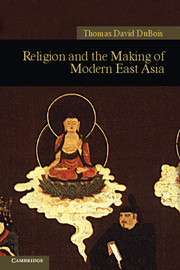Book contents
- Frontmatter
- Contents
- List of Boxes, Figures, and Maps
- Preface
- 1 In the beginning: Religion and history
- 2 Ming China: The fourteenth century's new world order
- 3 The Buddha and the shōgun in sixteenth-century Japan
- 4 Opportunities lost: The failure of Christianity, 1550–1750
- 5 Buddhism: Incarnations and reincarnations
- 6 Apocalypse now
- 7 Out of the twilight: Religion and the late nineteenth century
- 8 Into the abyss: Religion and the road to disaster during the early twentieth century
- 9 Brave new world: Religion in the reinvention of postwar Asia
- 10 The globalization of Asian religion
- Glossary
- Timeline of dynasties and major events
- Suggestions for further reading
- Index
5 - Buddhism: Incarnations and reincarnations
Published online by Cambridge University Press: 05 June 2012
- Frontmatter
- Contents
- List of Boxes, Figures, and Maps
- Preface
- 1 In the beginning: Religion and history
- 2 Ming China: The fourteenth century's new world order
- 3 The Buddha and the shōgun in sixteenth-century Japan
- 4 Opportunities lost: The failure of Christianity, 1550–1750
- 5 Buddhism: Incarnations and reincarnations
- 6 Apocalypse now
- 7 Out of the twilight: Religion and the late nineteenth century
- 8 Into the abyss: Religion and the road to disaster during the early twentieth century
- 9 Brave new world: Religion in the reinvention of postwar Asia
- 10 The globalization of Asian religion
- Glossary
- Timeline of dynasties and major events
- Suggestions for further reading
- Index
Summary
Bodhisattvas and barbarians: Buddhism in Ming and Qing China
There were many factors behind the decline of Iberian Catholicism in China and Japan, but one condition that missionaries in both places shared in common was the determined opposition of Buddhist monks and their allies. The reason behind this opposition, other than simple chauvinism, was that Buddhism was itself fighting for political prominence, and the strange new religion was making that endeavor more difficult. But just as Christianity faced different challenges in entering China and Japan, so too did Buddhism adapt to the rapidly changing political circumstances.
Although Zhu Yuanzhang never persecuted Chinese Buddhism as such, the new preeminence of Confucianism cast a long shadow. Ming laws propagated Confucian values and upheld a Confucian intellectual orthodoxy. The dynasty's elites earned their status not by heredity or imperial favor, but by their mastery of Confucian scholarship. Entire extended families devoted resources to training their most promising children to take these examinations one day. Even if examination success did not necessarily lead to a coveted position in the imperial bureaucracy, degree holders earned privileges that set them apart from other commoners: they had the right to travel by sedan chair, to post a flag in front of their house, and to seek an audience with the county magistrate. Because of their elite status, this class is sometimes termed China's gentry. They were the keepers of the flame, by definition devoted to Confucianism.
- Type
- Chapter
- Information
- Religion and the Making of Modern East Asia , pp. 94 - 122Publisher: Cambridge University PressPrint publication year: 2011

